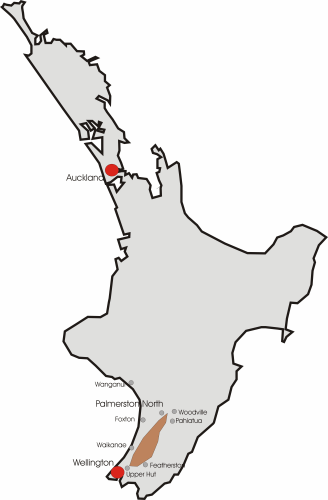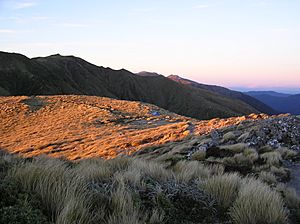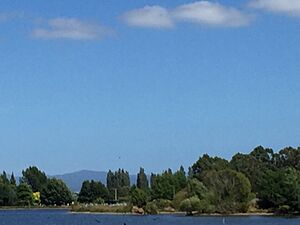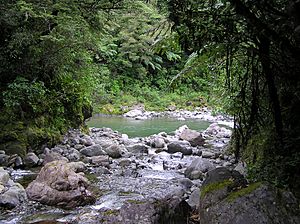Tararua Range facts for kids
Quick facts for kids Tararua Range |
|
|---|---|

Tararua Range from Wairarapa
|
|
| Highest point | |
| Peak | Pukeamoamo / Mitre |
| Elevation | 1,570 m (5,150 ft) |
| Geography | |
| Country | New Zealand |
| Range coordinates | 40°46′S 175°23′E / 40.767°S 175.383°E |
The Tararua Range is a group of mountains in the North Island of New Zealand. People often call it the Tararua Ranges or just Tararua. It is one of several mountain ranges found in this part of the country.
The Tararua Range stretches for about 80 kilometers (50 miles). It runs from near Palmerston North down to the top of the Hutt Valley. Here, it meets the northern end of the Remutaka Range. To the north, the Manawatu Gorge separates it from the Ruahine Range.
The highest point in the Tararua Range is Pukeamoamo / Mitre. This peak stands tall at 1,570 meters (5,150 feet). Other important peaks include Mount Bannister at 1,537 meters (5,043 feet). There is also Mount Hector at 1,529 meters (5,016 feet). Mount Hector is named after a scientist, Sir James Hector. Its Māori name, Pukemoumou, means 'hill of desolation'.
Contents
Where are the Tararua Mountains?
The Tararua Range has two main parts: a northern and a southern area. Each part has a central mountain peak. Arete is in the north, and Hector is in the south.
Ten rivers start on the slopes of these mountains. They provide water to nearby towns and farms. These areas stretch from Palmerston North to Wellington. Many smaller ranges branch out from the main mountains. The biggest one is the Main Range. It connects the northern and southern peaks.
The tops of these ranges are usually between 1,300 and 1,500 meters high. This even height suggests the area was once a flat plain. About 10 million years ago, parts of this low-lying land were pushed up. This created the mountain backbone for the southern North Island. Over time, erosion shaped the land. This created the parallel ranges and deep river valleys we see today. The ranges form a beautiful background for the Kapiti Coast plain.
Tallest Mountain Peaks
Here are 15 peaks in the Tararua Range that are 1,500 meters (4,921 feet) or higher. They are listed from north to south:
- Logan 1,500m
- Bannister 1,537m
- South Bannister 1,513m
- Arete 1,505m
- Lancaster 1,504m
- Brocket 1,538m
- Pukeamoamo / Mitre 1,571m
- Peggys Peak 1,545m
- Girdlestone 1,546m
- North King 1,535m
- Middle King 1,521m
- South King 1,531m
- McGregor 1,540m
- Angle Knob 1,510m
- Mount Hector 1,529m
Other well-known peaks in the range include Jumbo Peak (1405m) and Mount Holdsworth (1470m).
What is the Weather and Nature Like?
The western side of the mountains gets a lot of rain. This is because of winds carrying moisture from Cook Strait. About 5,000 mm (197 inches) of rain falls here each year. Because of this, the western slopes have many conifers, ferns, and shrubs.
The eastern side is much drier. Here, you will mostly find open beech forests. Even though the Tararua Range can seem gloomy, it has many different plants. You can find alpine tussock grasslands and subalpine shrublands. There are also forests of miro and kamahi trees. Some areas have beech or lowland broadleaf forests. These include tall podocarps and kamahi.
In the northern Tararua Range, the forests are mostly tawa and miro trees. Further south, beech trees are common. On the western slopes facing the Tasman Sea, you will find mixed native trees. These include rimu, tarrier, matai, totara, and kahikatea.
A Look Back at the Tararua Range
The rough land and often bad weather of the Tararua Range made it hard for early Māori to explore deeply. There is proof that moa hunters visited as early as the 1100s. But the mountains remained a huge natural barrier. They separated tribal groups living along rivers, lakes, and coastlines.
Some of the Ngati Mamoe, early Māori settlers, found safety in the Tararua mountains. This happened after they were forced out by the Rangitane and Muaupoko iwi (tribal groups). These Ngati Mamoe survivors became known as the patupaiarehe, or 'fairy folk,' of the Tararua Range. In the 1820s, the Muaupoko also had to flee to the ranges. This was when they were attacked by the Ngāti Toa, led by Te Rauparaha. Despite these events, the mountains were seen as a special place. It was a home for distant gods or wild men, and people respected it but often avoided it.
In the 1870s, a large part of the ranges was sold to the New Zealand Government. This was done by a group of Iwi from the surrounding area. An area of 1,000 acres was kept aside. This was to protect the sacred lake Hapuakorari, but its exact spot was not clear.
European settlers also found the steep ridges and deep valleys hard to get to. The range was so big that it was not developed like the fertile plains next to it. In 1881, 36,000 acres of the Tararua area became a State Forest. This meant it was protected. More areas were added over the years. This created a large protected reserve of over 250,000 acres.
The beautiful views of the Tararua Range made it a popular subject for paintings. By the 1920s, people started to see the range as a great place for outdoor fun. It was no longer just a place to be used for resources.
Exploring Tararua Forest Park
The Tararua Forest Park covers more than three-quarters of the Tararua Range. It is a huge area of 116,535 hectares (288,000 acres). The New Zealand Department of Conservation looks after it. The park stretches from the Pahiatua Track in the north to the Rimutaka Saddle in the south. The main way to enter the park on the eastern side is at Holdsworth. On the west side, you can enter from Ōtaki Forks.
Getting Around the Tararua Range
The "Pahiatua Track" is the only road that goes all the way across the range. It connects Palmerston North and Pahiatua. This road is used a lot more now. This is because the Manawatu Gorge road closed in 2017 due to big landslides.
Fun Activities in the Tararua Range
The Tararua Range is a very popular place for tramping (hiking) for people in the Wellington area. It is one of the most visited mountain ranges in New Zealand. Between 120,000 and 150,000 people visit it every year.
One famous tramping track is the "Southern Crossing". It starts at Ōtaki Forks in the west. It goes over Mount Hector and ends near Kaitoke.
Camping
There are six campsites in the hills. You can reach them by car. However, you might need to drive on gravel roads. These roads sometimes have small river crossings called fords. The campsites are usually found in the lower parts of the range, next to a river or stream.
Tramping Adventures
The Tararua Range is important in the history of tramping in New Zealand. This is because it is easy for people from Wellington and nearby towns to get to.
In April 1933, a famous event happened here. It was called The Sutch Search. Four people, Eric Hill, Morva Williams, Bert O’Keefe, and Dr. Bill Sutch, went missing. They were trying to hike from Te Matawai Hut to Mount Holdsworth in winter. An accident made them get lost. Bad weather then forced them off the main ridges. It took them over two weeks to find their way down the Waiohine River.
After a week, people realized they were missing. A search began with about 200 people. Many members of the public also donated money to help. This search was the first in New Zealand to use radio and aircraft. It helped lead to the creation of New Zealand's volunteer Land Search and Rescue service (LSAR). The media covered the story a lot. When the group finally returned, it started a big public discussion. People talked about how much responsibility hikers have when they go into the wilderness.
The Tararua Range has steep land, thick bush, hard river crossings, and changing winter weather. These conditions have led to some accidents over the years.
Mountain Running Races
The Tararua Mountain Race is a running event held every year since 1990. The race is 35.4 kilometers (22 miles) long. It goes from Kaitoke to Ōtaki Forks. Runners climb a total of 2,250 meters (7,380 feet) and then go down a bit more. About 50 volunteers help with the race. They act as marshals, first aid helpers, and support staff. The race often has bad weather. It is not for people who are new to mountain running.
See also
 In Spanish: Montes Tararua para niños
In Spanish: Montes Tararua para niños








